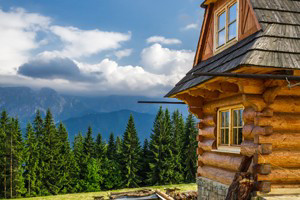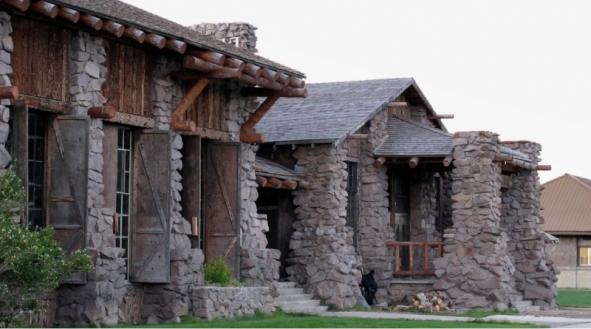Inside Yellowstone National Park
There is one primary road that lets visitors easily explore all of Yellowstone's magnificent features and attractions. It forms a figure 8 and is accessed by five off-shoots from surrounding gateway towns. To visit the park in two days, you can cover the upper loop of the figure 8 on day one and the lower loop on day two. If you have more time, of course, you'll be treated to much more exploration and discovery. Driving clockwise from the north entrance, here are all the "neighborhoods" within the park.
- Mammoth Hot Springs: Located just inside the North Entrance, the Mammoth Hot Springs area features the Albright Visitor Center, Fort Yellowstone, Mammoth Terraces, a year-round campground and hotel, and many hiking trails.
- Tower-Roosevelt: Head west from Mammoth and bump into the Tower Roosevelt area, which creates a gateway for Lamar Valley and the northeast entrance. Lodging includes Roosevelt Lodge and Cabins and you'll won't want to miss checking out the Petrified Tree, Tower Fall, Mount Washburn, and nearby Lamar Valley.
- Canyon Village: South of Tower Roosevelt, make some time to explore the Grand Canyon of the Yellowstone River, the primary attraction in this area. There are multiple viewing points and trails that lead down into the canyon. Nearby Canyon Lodge and campground offer lodging options. From Canyon Village, you can either head west to Norris Basin or further south to Lake Village.
- Lake Village: On the upper banks of Yellowstone Lake you'll find three small villages (Bridge Bay, Lake Village, and Fishing Bridge). You'll find campgrounds, lodging options, stores, visitor centers, and hiking trails. Take a hike to Natural Bridge or into the backcountry in Pelican Valley. Rent a motor boat at Bridge Bay or join a Scenic Lake Cruise with a ranger. From Lake Village you can head east to the East Entrance or continue south to West Thumb.
- West Thumb: West Thumb and Grant Village are located along the southern shores of Yellowstone Lake and offer boardwalk trails, numerous hiking trails, camping and lodging, dining, and some visitor services. Check out the West Thumb Geyser Basin, go kayaking on Yellowstone Lake, pop into the West Thumb Visitor's Center, or hike to Shoshone Lake. From West Thumb, continue south to Grand Teton National Park or northwest to the Old Faithful area.
- Old Faithful: The epicenter of Yellowstone features not only the most popular geyser in the park, but many geothermal features, hiking trails, and attractions. Make some time for the Upper, Midway, and Lower Geyser Basins, as well as a visit to the Visitor Education Center and the Old Faithful Inn. No camping here but a few shops and dining options.
- Madison: Head north from Old Faithful to find the Madison area. Not many services here other than a campground, but it is the junction for accessing West Yellowstone. Don't miss Gibbon Falls and the Firehole Canyon Drive.
- Norris: Norris marks the crossroads of the figure 8 loop drive. You can either head north back to Mammoth or east to Canyon Village. There is a campground and museum at Norris and a number of interesting features nearby, including Steamboat Geyser and Artist Paint Pots.
Gateway Towns
Numerous gateway towns and communities surround Yellowstone National Park. Bop around from town to town or settle down in one area as your home base. Here are the gateway communities, clockwise from the north entrance.
- Gardiner: At the North Entrance sits the small town of Gardiner. It's very much a tourism based town with a variety of lodging options, a private RV park, diners, and souvenir shops dotted along a wooden boardwalk. Drive further north and you'll run into the picturesque Paradise Valley, Chico Hot Springs, and eventually Livingston, a cool funky town just east of Bozeman. Note: This is the only entrance that is open to vehicles in the winter and the road is plowed all the way to Cooke City.
- Cooke City: Just outside the Northeast Entrance to the park, Cooke City is a quaint village that ebbs and flows with the visitor seasons of Yellowstone. There are a handful of motels and one-of-a-kind inns, as well as a few places to eat. If you continue east you can either follow Beartooth Pass into Red Lodge or take the Chief Joseph Highway southeast to Cody. In the winter, Beartooth Pass is closed while a 10 mile section along Chief Joseph Highway remains open ONLY to snowmobiles.
- East Yellowstone: Exit the East Entrance to Yellowstone and you'll discover an area known as East Yellowstone that encompasses the valley between Yellowstone and Buffalo Bill Reservoir. There is no town per se but numerous lodges and ranches that treat their guests to unique lodging experiences and all-inclusive activities and amenities. It takes just under and hour to drive to the town of Cody from the East Entrance. This entrance is closed in the winter.
- Grand Teton Park/Jackson Hole: Head south from Yellowstone and you'll run into Grand Teton National Park and eventually Jackson Hole. Jackson is a thriving mountain town with tons of lodging options, fantastic restaurants, and a hopping town square. Jackson is also home to world renowned Jackson Hole Mountain Resort, a superb skiing destination in the winter. You can access Yellowstone via snowcoach or snowmobile only in the winter.
- West Yellowstone: Just outside the West Entrance, the town of West Yellowstone is probably the busiest of gateway towns. A large variety of lodging options suit most needs. You won't find any fine dining experiences here but a taco stand in a bus, BBQ shack, a verity of diners, and a small grocery store will do the trick. Head north from West Yellowstone to Big Sky, Montana and eventually Bozeman. West is a booming winter destination for snowmobile and nordic skiing enthusiasts. Winter visitors can enter the park via over snow vehicles only.





